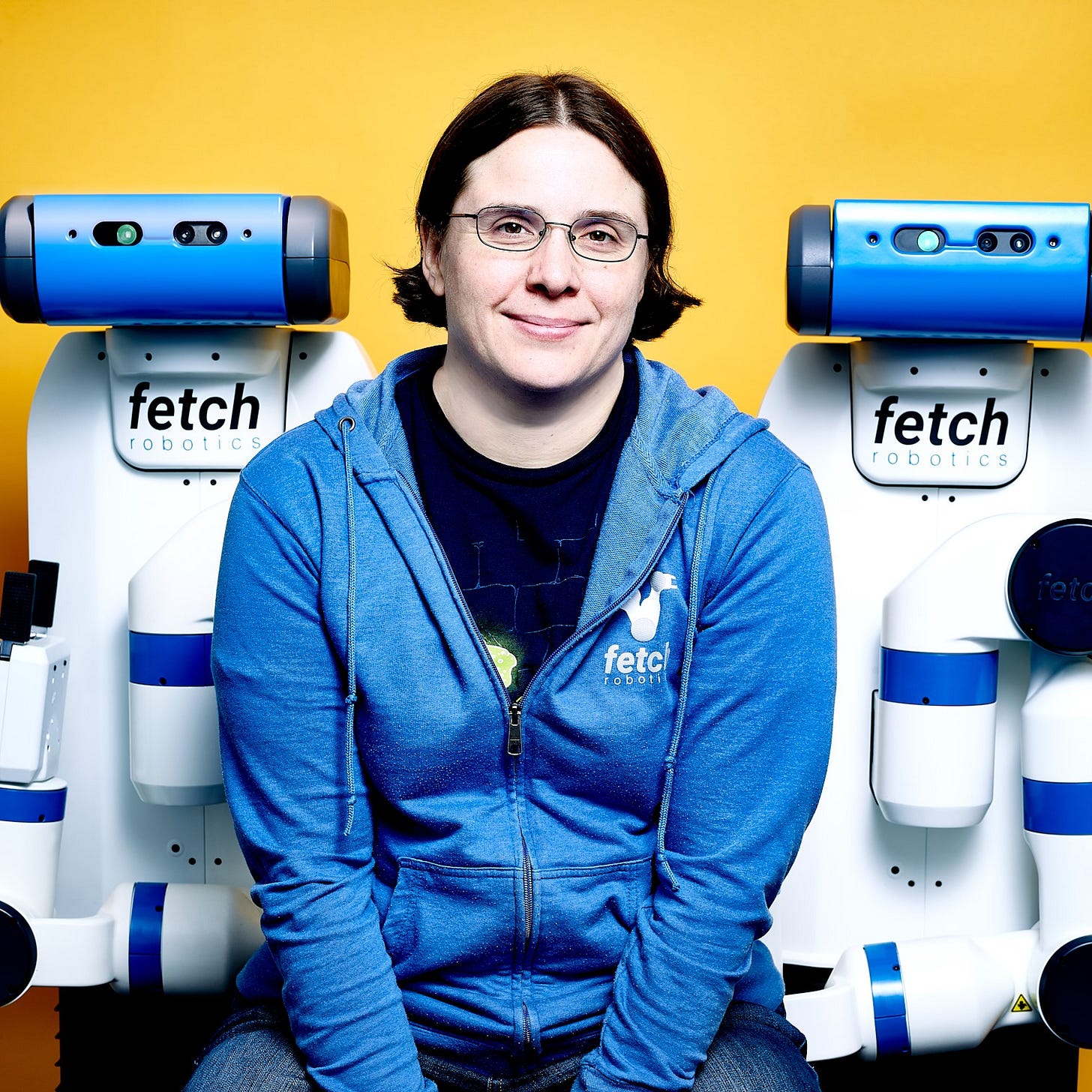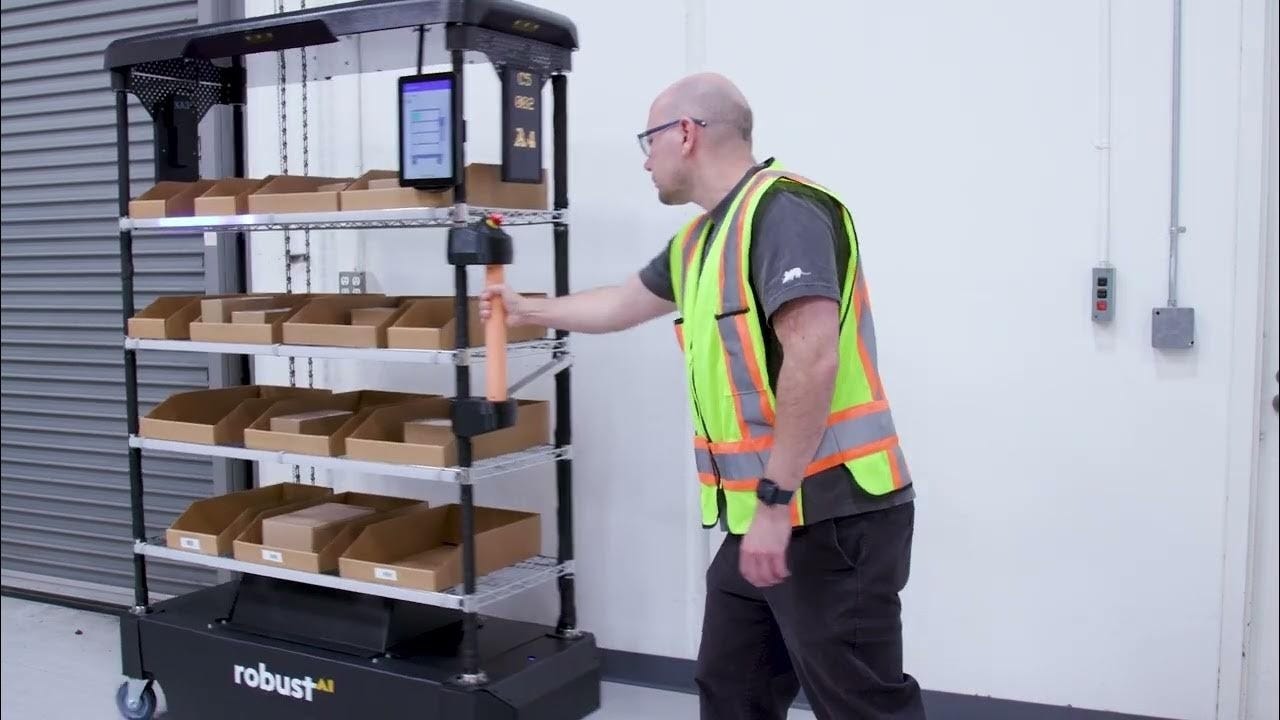The Rise of the Engineer-Philosopher in Robotics Leadership
Why the future of automation depends on leaders who think in algorithms—and ethics.
Aaron’s Thoughts On The Week
“The real problem of humanity is the following: we have Paleolithic emotions, medieval institutions, and god-like technology.” — E.O. Wilson
In a world where machines are becoming more intelligent, responsive, and autonomous, the question is no longer just what robots can do—but why they do it, who benefits, and how they fit into the broader human experience. The people leading their development can no longer be defined solely by their technical prowess or business acumen. As robotics continues to blur the lines between software and hardware, utility and ethics, automation and society, the leaders of tomorrow’s robotics companies must rise to a new standard. They’ll need not only engineering degrees and strategic instincts, but also philosophical clarity, cultural fluency, and the ability to navigate increasingly complex social, environmental, and ethical terrains with human-centric foresight.
The Changing Face of Robotics Leadership
The traditional archetype of a robotics CEO has been the inventor-founder: someone with deep technical expertise, often coming from academia or R&D labs, pushing the frontier of what machines can do. Figures like Rodney Brooks (co-founder of iRobot, Rethink Robotics, and Robust.ai) and Marc Raibert (Boston Dynamics) have made profound contributions by embodying this model, driving innovation from the lab bench to the factory floor. However, as robotics moves into everyday environments—warehouses, hospitals, homes, and cities—this model, though, is facing new limitations.
Today’s robotics challenges are no longer just technical; they are systemic and social. Robots are now expected to coexist with humans, operate safely in complex public spaces, adapt to uncertain workflows, and align with emerging ethical norms. These expectations require a very different type of leadership—one that balances technical depth with a broad understanding of systems and human insight.
Modern robotics leaders must now think like sociotechnical architects. They must understand systems thinking, communicate clearly with non-technical stakeholders, and anticipate the cascading impacts of their technologies across industries, communities, and cultures. This includes awareness of public perception, legal and ethical frameworks, workforce disruption, and cross-sector collaboration.
The modern robotics CEO must be part engineer, part philosopher—a translator between bits and values. They are no longer just inventors; they are cultural intermediaries. Those who lead the next wave of robotics innovation must do so with the humility to learn from other disciplines, the empathy to design for real human needs, and the strategic vision to guide their organizations through a time of technological and societal transformation.
Some Examples Of These “New” Leaders
There are many examples of robotics leaders today who are demonstrating the blend of engineering expertise and philosophical foresight, but in the interest of brevity, we’ll highlight just a few standout voices:
Melonee Wise – Chief Product Officer at Agility Robotics
Melonee Wise has been a transformative figure in the robotics industry. As the second employee at Willow Garage, she played a pivotal role in developing the Robot Operating System (ROS), PR2, and TurtleBot, laying the groundwork for modern robotics software and hardware integration. She later co-founded Fetch Robotics, focusing on autonomous mobile robots (AMRs) for warehouse automation. Under her leadership, Fetch Robotics advanced the deployment of AMRs, emphasizing safety and efficiency in logistics operations. After Fetch's acquisition by Zebra Technologies, Wise continued to advocate for the integration of robotics into human-centric workflows. Currently, at Agility Robotics, she leads product development for Digit, a bipedal robot designed to work alongside humans, reflecting her commitment to creating robots that augment human capabilities rather than replace them.
"We need to design robots that work with people in mind—not just to do tasks, but to make people’s jobs safer, easier, and more fulfilling." — Melonee Wise
Ayanna Howard – Dean of the College of Engineering at Ohio State University
Dr. Ayanna Howard is a distinguished roboticist whose work bridges technical innovation and societal impact. With a background at NASA's Jet Propulsion Laboratory, she contributed to the development of intelligent systems for space exploration. Her research has since focused on human-robot interaction, accessibility, and the ethical implications of robotics and AI. As the founder of Zyrobotics, she developed educational technologies to support children with diverse learning needs. In her academic leadership roles, including her current position at Ohio State University, Dr. Howard champions diversity in STEM and the responsible development of technology, emphasizing the importance of inclusive design and ethical considerations in engineering education and practice.
“We must ensure that the technology we create serves humanity, especially those who have traditionally been left out of the innovation conversation.” — Ayanna Howard
Jake Loosararian – CEO and Co-founder of Gecko Robotics
Jake Loosararian leads Gecko Robotics, a company that develops wall-climbing robots equipped with sensors to inspect and maintain critical infrastructure, including power plants and naval vessels. Under his leadership, Gecko Robotics has expanded its role in national defense, emphasizing the importance of robotics in maintaining the integrity of essential systems. Loosararian advocates for the integration of robotics into sectors that are vital for national security and economic stability, highlighting the broader societal implications of robotic technologies.
“We’re not just building robots to automate tasks—we’re building them to protect what matters most. Infrastructure, safety, and the future of our economy depend on it.” — Jake Loosararian
These leaders exemplify the fusion of engineering excellence with a deep understanding of the broader implications of robotics, guiding the industry toward innovations that are both technically advanced and socially responsible.
Philosophers in the Boardroom: Why It Matters
As robots enter our homes, care facilities, public spaces, and logistics centers, they no longer automate routine tasks—they influence how we move, interact, and even trust technology. A warehouse robot that moves too fast may boost productivity, but at the cost of worker anxiety or injury. A caregiving robot that cannot detect emotional cues might complete its checklist but fail to assist the human it was intended to help effectively. These examples reveal that robotics leadership is no longer solely about optimizing functionality—it’s about designing systems that align with human values.
This evolution demands a philosophical approach to leadership, not in the abstract, academic sense, but as a practical lens for navigating high-stakes, morally ambiguous decisions. Strategic leaders must now grapple with questions such as: How do we define fairness when machines allocate labor or prioritize actions? How do we preserve dignity and autonomy in automated care settings? And how do we ensure that algorithmic decision-making remains accountable?
Philosophical leadership, in this context, requires executives to embed ethics, trust, and human-centered design directly into their business strategies. That means building technologies that are transparent, understandable, and capable of earning user trust—not just compliance. According to the World Economic Forum, trust in AI systems is emerging as a competitive differentiator, with companies that proactively design for explainability and fairness gaining reputational and financial advantages.
Additionally, these leaders must foster corporate cultures that emphasize collaboration over control. In an era when automation is often equated with labor displacement, cultivating a workplace narrative that centers on human-robot collaboration, rather than replacement, becomes crucial for long-term adoption. As reported in the MIT Sloan Management Review, organizations that thrive in the age of intelligent machines prioritize empathy, learning, and adaptability at every level.
Perhaps most importantly, philosophical leaders understand that every automation decision entails a trade-off, not just between efficiency and cost, but between speed and safety, innovation and inclusion. These aren’t problems that better code or sensors alone can solve. They require leaders with the ability to reason through ethical dilemmas, communicate transparently, and design technology that is not only effective but also equitable.
As AI systems become increasingly complex and integrated into society, emergent behaviors will challenge even the most well-intentioned strategies. CEOs will need more than technical foresight—they’ll need moral frameworks to anticipate the unanticipated. Leadership in robotics is no longer just about directing machines; it is also about guiding people. It’s about guiding missions that intersect with people’s lives in deeply personal and often invisible ways.
Systems Thinking as a Core Competency
Another defining trait of tomorrow’s robotics leaders will be their fluency in systems thinking—the ability to see beyond the robot itself and understand the broader ecosystem in which it operates. This includes how automation shapes the rhythm and nature of human labor, how data flows between interconnected machines and cloud platforms, and how policies, public sentiment, and industry standards influence adoption and trust.
Rather than viewing innovation as a technical endpoint, these leaders understand that every robot operates within a complex web of human, digital, and institutional relationships. A decision to accelerate throughput in a factory, for example, may ripple out to impact ergonomic stress on workers, energy consumption on the grid, and the public perception of robotics in employment.
This is where being “half philosopher” becomes a strategic advantage. Systems-thinking leaders can model complexity, anticipate unintended consequences, and communicate those trade-offs with clarity. They design for long-term adaptability, recognizing that resilient strategies depend on feedback loops, inclusive collaboration, and an evolving understanding of the human-machine dynamic.

What the Industry Must Do to Foster These Leaders
To build a generation of engineer-philosophers, the robotics industry must rethink its leadership pipelines, starting not just in graduate programs or boardrooms, but from early education through to executive development.
Educate for breadth: Technical excellence alone is no longer enough. Robotics education should include coursework in ethics, sociology, systems thinking, and environmental impact. Programs like Stanford’s Ethics, Society, and Technology initiative or MIT’s Responsible AI efforts demonstrate how cross-disciplinary training can shape more conscientious engineers.
Mentor beyond the lab: Researchers and developers should be encouraged to work closely with end-users, community stakeholders, and frontline workers, not just with simulations or idealized environments. Programs like NSF's Convergence Accelerator emphasize user-centered research, ensuring technology responds to lived experience.
Reward responsible innovation: Too often, incentives focus on speed and scale. However, companies like Robust.AI and Agility Robotics are demonstrating that thoughtful design—prioritizing ease of use, transparency, and user trust—can be just as crucial to long-term success. Industry awards and investment criteria should evolve to recognize leaders who build with empathy, ethics, and resilience in mind.
Diversify leadership paths: The next generation of robotics leaders shouldn't come only from traditional engineering roles. Bringing in perspectives from urban planning, public health, disability advocacy, and social science can challenge technical monocultures and foster truly inclusive innovation. Organizations such as AI4ALL and Women in Robotics are actively working to broaden the field’s leadership pool and skill sets.
If the future of robotics is to be integrated, ethical, and widely accepted, its leadership must reflect the full range of perspectives needed to make that future possible.
As robotics moves from isolated applications into the fabric of daily life, its leaders must evolve. We need visionaries who see robots not just as tools but as participants in human systems. Leaders who code not just in Python, but in purpose. Who optimizes not just for throughput, but for trust.
The future robotics CEO is already emerging. You’ll know them when you see them: they ask different questions, listen more than they speak, and build with both precision and care.
And if we’re lucky, the next great robotics breakthrough might just come from someone holding a wrench in one hand and a copy of The Republic in the other.
Robot News Of The Week
Robust.AI expands Carter cobot’s capabilities for multi-function warehouse automation
Robust.AI has announced major upgrades to its Carter platform, transforming it into a multifunctional warehouse robot that can handle picking, transport, and sorting—all on a single software-defined system. Deployed across DHL warehouses, including in Las Vegas, Carter has shown over 60% productivity gains. The platform’s flexibility helps logistics teams streamline workflows without extra hardware. CEO Anthony Jules emphasized Carter’s human-centric design and ease of use. Robust.AI also secured new funding from APL Ventures and 15th Rock to support growth and develop next-gen collaborative robotics for the supply chain.
Waterloo Startup Axibo AI Secures $12M to Pioneer 'Made in Canada' Humanoids
Axibo Inc., a robotics company based in Waterloo and known for its 4D volumetric capture tech used by Netflix and Apple, has raised $12 million—$11M from investors and $1M from its founders. The funding will launch a new humanoid robotics division. Co-founder Anoop Gadhrri calls humanoids the next industrial leap and aims to make Canada a leader in this space. Axibo is hiring engineers to help build intelligent robots for healthcare, logistics, and personal use, with its first humanoid prototype, “T.E.B.,” expected in early 2026.
Comau to acquire warehousing automation firm Automha in strategic expansion
Comau, an Italian robotics company, has signed a binding agreement to acquire Automha, a specialist in warehouse and intralogistics automation. The deal, expected to close in Q2 2025 pending regulatory approval, marks a major step into the logistics sector for Comau and reinforces its Italian manufacturing base.
The acquisition will allow Comau to scale its innovation efforts and expand its global reach, while Automha retains its leadership and operations. The companies aim to combine strengths for greater competitiveness in industrial automation. This move aligns with Comau’s growth strategy under new ownership by One Equity Partners.
Robot Research In The News
Robot see, robot do: System learns after watching how-tos
Cornell researchers have developed RHyME, a new AI framework that lets robots learn complex tasks by watching just one how-to video. Traditional robot training requires extensive, rigid data collection, but RHyME enables robots to adapt and improvise by referencing similar past experiences—making them far more efficient and scalable.
In tests, RHyME-trained robots saw over 50% improvement in task success, using only 30 minutes of robot data. The breakthrough, led by PhD student Kushal Kedia and Prof. Sanjiban Choudhury, represents a major leap in imitation learning and could accelerate real-world robot deployment.
Physical Intelligence rented a bunch of Airbnbs to test how a home robot adapts to new environments
Bay Area robotics startup Physical Intelligence, which raised $400M last year from backers like OpenAI and Jeff Bezos, is showcasing progress on its vision-language-action (VLA) model, π0.5. The company tested its robots in various rented Airbnbs to demonstrate the model's ability to generalize tasks—like cleaning kitchens or bedrooms—across different environments. While the robot showed adaptability and could learn from verbal feedback, challenges remain in improving dexterity, autonomy, and knowledge transfer. The goal: robots that can function reliably in unfamiliar, real-world settings with minimal supervision.
Robot Workforce Story Of The Week
More than 15,000 students from 17 countries gathered in Houston this week for the FIRST Championship, a global robotics showdown where high school teams battle bots—and build futures. From dodgeball “algae” challenges to climbing 150-pound robots, the competition is a showcase of next-gen engineering. NASA, Boeing, and others are watching closely, scouting tomorrow’s STEM leaders. For some teams, like Arizona’s CocoNuts, it’s also about spreading opportunity and impact beyond the arena.
Robot Video Of The Week
Move over, Boston—this week’s hottest race wasn’t human. In China, a squad of bipedal bots literally ran the show at the world’s first Humanoid Half Marathon! Sure, some stumbled, a few faceplanted, and one might’ve “pulled a servo”… but six finished all 13.1 miles like absolute cyborg champs.
Upcoming Robot Events
Apr. 30-May 1 Robotics Summit (Boston, MA)
May 12-15 Automate (Detroit, MI)
May 17-23 ICRA 2025 (Atlanta, GA)
May 18-21 Intl. Electric Machines and Drives Conference (Houston, TX)
May 20-21 Robotics & Automation Conference (Tel Aviv)
May 29-30 Humanoid Summit - London
June 9-13 London Tech Week
June 17-18 MTC Robotics & Automation (Coventry, UK)
June 30-July 2 International Conference on Ubiquitous Robots (College Station, TX)
Aug. 17-21 Intl. Conference on Automation Science & Engineering (Anaheim, CA)
Sept. 15-17 ROSCon UK (Edinburgh)
Sept. 27-30 IEEE Conference on Robot Learning (Seoul, KR)
Sept. 30-Oct. 2 IEEE International Conference on Humanoid Robots (Seoul, KR)
Oct. 6-10 Intl. Conference on Advanced Manufacturing (Las Vegas, NV)
Oct. 15-16 RoboBusiness (Santa Clara, CA)
Oct. 19-25 IEEE IROS (Hangzhou, China)
Oct. 27-29 ROSCon (Singapore)
Nov. 3-5 Intl. Robot Safety Conference (Houston, TX)
Dec. 11-12 Humanoid Summit (Silicon Valley TBA)









